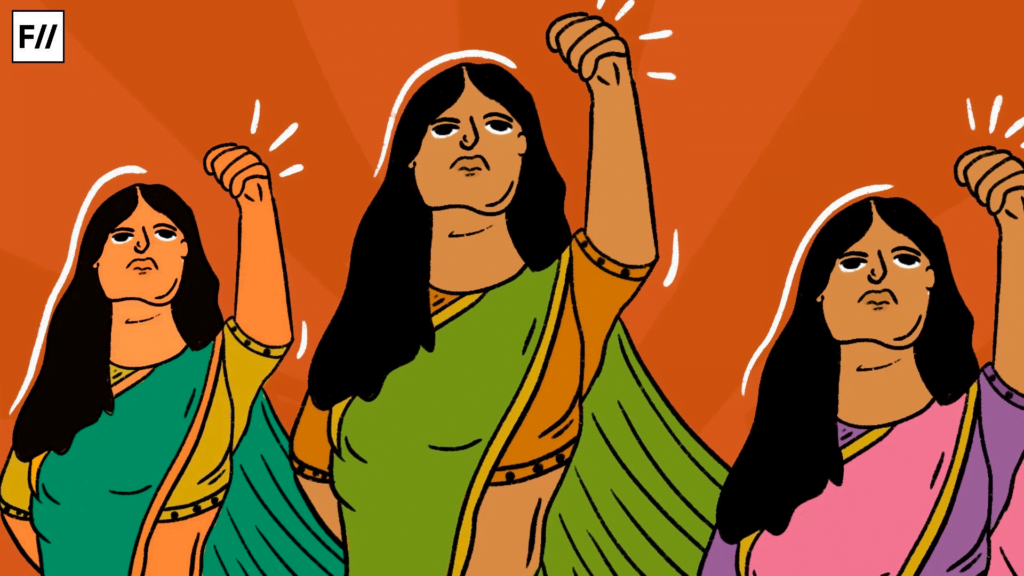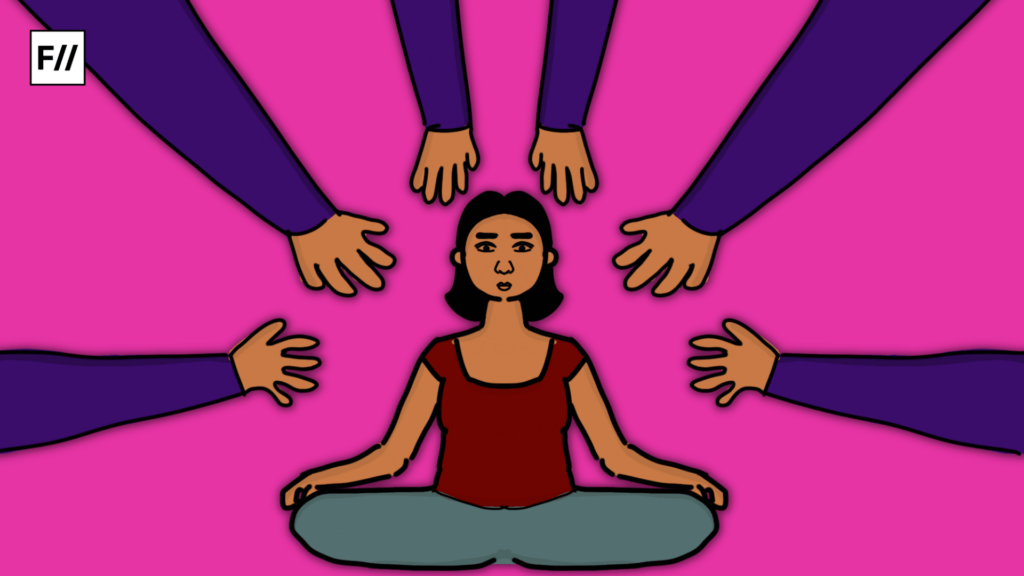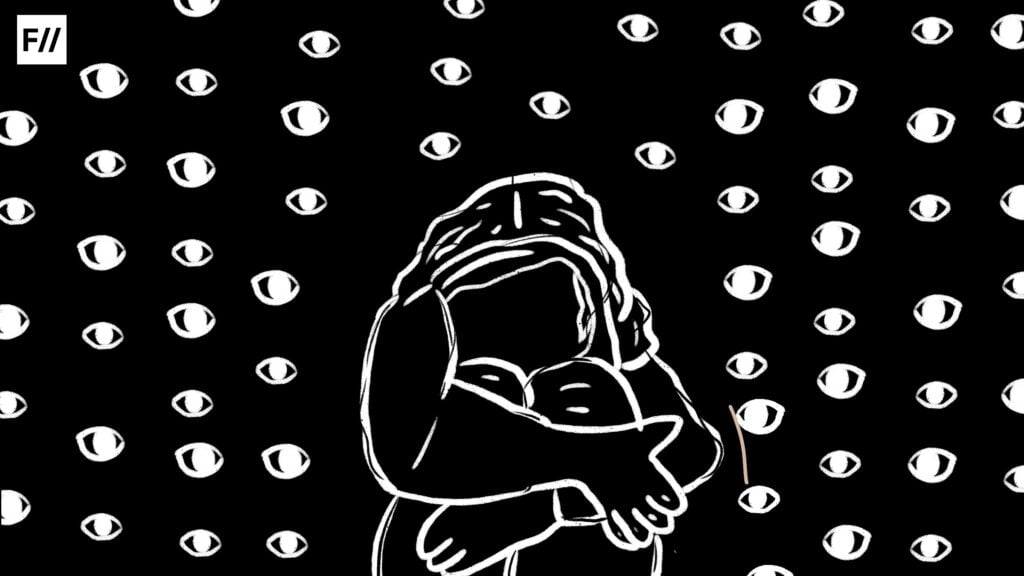Trigger Warning: This article mentions the recent Delhi murder and gender-based violence.
Indian civilisation restores its purity by waging a permanent war against Indian women. On May 29, 2023, a 16-year-old girl named Sakshi was stabbed multiple times and bludgeoned to death in Delhi by her 20-year-old boyfriend Sahil, even as bystanders and pedestrians apathetically walked past the scene of the attack. What drove the man to carry out the killing was the girl’s decision to end the relationship. The political response to this gruesome incident highlights the rottenness of Indian democracy. Chief Minister Arvind Kejriwal has framed the event as a “law and order” issue in which criminals have lost their “fear of the police”.
What is common to both the legalistic and Islamophobic reactions is the elision of the systemic violence that forms the patriarchal identity of the Indian nation. While the vocabulary of juridical formalism reduces anti-women violence to a localised eruption of lawless emotions (“crime of passion”), communal propaganda outsources a socio-structural disease onto the Muslim community.
Delhi Bharatiya Janata Party (BJP) chief Virendra Sachdeva has subsumed it under the communal rubric of “love jihad” – a right-wing conspiracy theory that accuses Muslim men of forcing Hindu women to convert to Islam.
Systemic violence
What is common to both the legalistic and Islamophobic reactions is the elision of the systemic violence that forms the patriarchal identity of the Indian nation. While the vocabulary of juridical formalism reduces anti-women violence to a localised eruption of lawless emotions (“crime of passion”), communal propaganda outsources a socio-structural disease onto the Muslim community.

Instead of individualising the violent behaviour of the murderer in the external particularity of intense emotions or alien identities, we need to situate it in the interiority of the bodies and personalities that compose masculinity. Far from being an aberration from the healthy standards of Indian civilisation, the cruel behaviour of Sahil is reflective of the particles of patriarchal fascism that reside in every Indian man.
At this point of the argument, one will inevitably hear the disgruntled cries of people who think that “not all men” are responsible for gender-based violence. The implication of this perspective is that a few enlightened men can rise above the muck of patriarchy to absolve themselves of any responsibility for what other men are doing to women.
As Baruch Spinoza said, it is necessary to consider heinous effects “not as corruptions of human nature, but as properties that pertain to it just as heat, cold, storms, thunder and other such things pertaining to the atmosphere, while inconvenient, are necessary and have causes through which we attempt to understand their nature, and the mind has as much pleasure in contemplating these things as in knowing those things that please the senses.”

Patriarchal fascism in India is churned out by a capitalist-casteist ruling class whose power is enacted through the inscription of authoritarian traits on the bodies of men. When Karl Marx was writing about commodity fetishism, or how commodities come to dominate individuals in a capitalist society, he noted: “The relations connecting the labour of one individual with that of the rest appear, not as direct social relations between individuals at work, but as what they really are, material relations between persons and social relations between things [emphasis mine].” Capitalist domination is not a mere ideological illusion from which we can extricate ourselves through pedagogic awareness. Rather, it is a social structure of wage slavery and market dependency that exercises a very real influence upon the existential rhythm of the masses.
The materiality of capitalist power foregrounds the structural mechanisms through which the ruling class curtails our lives by imposing endless work and commodifying wider swathes of society. In terms of character structure, capitalism entails a form of socialisation in which there is no cooperation for a common good. There is only the cold calculus of self-aggrandisement, which quantifies society into two diametrically opposed constituents – “winners” and “losers”.

Such a numerical conception of exactly measurable identities and social worth provides the general matrix in which the egocentrism of conservative social identities can operate. In India, the graded inequality and mutual exclusivity of the caste system reify the winner/loser duality of the market into the traditionalist separation of birth-based destinies. These forms of non-relational sociality, commanded by the capitalist imperative of endless work, create the mass psychology of phallocentrism: women are positioned as an inferior race from whom unpaid labour is to be extracted through the terroristic deployment of physical violence and sexual subordination.
Disrupting the sexist power
The hardened crusts of historically accumulating oppressions prepare the bedrock for the emergence of patriarchal fascism. This is a social relation in which the market Manicheanism of winner/loser is articulated and experienced through the assertion of masculine power upon female bodies. Amidst the capitalist hellhole of ruthless competition and quantified identities, male violence constructs an axiological hierarchy in which the rigid cruelties of the market are recreated through the oppression of women.
This acts as a social template for the genocidal xenophobia of right-wing political formations. Since Indian men grow within the environment of patriarchal fascism, it is sheer ignorance to insist that “not all men” can be blamed for the violent acts of Sahil. In a patriarchal society, all relationships between men and women are political relationships whose dynamics are decided at the level of collective power struggle.
This acts as a social template for the genocidal xenophobia of right-wing political formations. Since Indian men grow within the environment of patriarchal fascism, it is sheer ignorance to insist that “not all men” can be blamed for the violent acts of Sahil. In a patriarchal society, all relationships between men and women are political relationships whose dynamics are decided at the level of collective power struggle.

In the absence of sustained feminist resistance, masculinity is invariably complicit in the silencing of women. In “Set Fear on Fire,” the feminist art collective LASTESIS proclaims: “We are mad. Mad in the face of the constant invisibility of our abuses. Why is it that all the women you know have been abused, but men don’t know a single abuser? Because they don’t see it. Because, in their privilege, our blood is invisible.” The presence of gender imbalances creates an amnesiac armature of self-assured masculinity, which disavows patriarchal violence through the synthetic rhetoric of “not all men”.
A basic unwillingness to acknowledge one’s entanglement in the coils of patriarchy and capitalism paves the way for the depoliticisation of every act of male violence as an exceptional event. It is against this background of masculine-centeredness that the words of the 1969 Redstockings Manifesto sound so coherent: “All men receive economic, sexual, and psychological benefits from male supremacy. All men have oppressed women.”
A basic unwillingness to acknowledge one’s entanglement in the coils of patriarchy and capitalism paves the way for the depoliticisation of every act of male violence as an exceptional event. It is against this background of masculine-centeredness that the words of the 1969 Redstockings Manifesto sound so coherent: “All men receive economic, sexual, and psychological benefits from male supremacy. All men have oppressed women.”
The recognition of the molecular patriarchal tendencies that affect each man doesn’t mean that men can’t participate in the feminist movement. On the contrary, it alerts us to the material institutions of women’s oppression whose continued existence allows men to enjoy undeserved privileges. Instead of saying “not all men,” the strategic perspective of feminism insists that we evolve habits and forms of life that disrupt the repeated enactments of sexist power on which patriarchal fascism depends. In her work on anti-fascism, Natasha Lennard comments that we need to conceptualise anti-fascist not as a “noun or adjective” but as a “gerund verb”: “a constant effort of anti-fascism against the fascisms that even we ourselves uphold.

Working to create nonhierarchical ways of living, working to undo our own privileges and desires for power. The individualised and detached self, the over-codings of family-unit normativity, the authoritarian tendency of careerism—all of them paranoiac sites of micro-fascism in need of anti-fascist care. We act against fascists in the knowledge we need to act against ourselves, too. The strategy is always to create consequences for living a fascist life and seek anti-fascist departures.”
In India, a feminist revolution against patriarchy and caste has to proceed through the mobilisation of collective ways of living that exist in combative tension with and annihilate the authoritarian personality of patriarchal fascism.
In the case of feminism, a similar dialectic of individual and social transformation has to be unleashed, so that the pre-fixed coordinates of patriarchy can be destroyed. LASTESIS writes: “Feminism must create tension in order to demolish violent practices inherited through institutions, social relations, and patriarchy. The feminist struggle, in this sense, is the practice of constantly swimming against the current.”
In India, a feminist revolution against patriarchy and caste has to proceed through the mobilisation of collective ways of living that exist in combative tension with and annihilate the authoritarian personality of patriarchal fascism.





Mainstream media does not inform us when women kill men. It is only a crime when a man does it.
21-year-old girl stabs boyfriend killing him on the spot.
https://voiceformenindia.com/pune-21-year-old-college-girl-stabs-boyfriend-on-chest-stomach-killing-him-on-the-spot/
Married woman pours hot boiling water on ex-partner, smashes him with beer bottle after he marries another woman.
https://voiceformenindia.com/married-woman-pours-hot-boiling-water-on-ex-partner-smashes-him-with-beer-bottle-after-he-marries-another-woman/
What you have mentioned is a serious issue and that is something that the world has to work upon. But the thing here is violence against women is way too common. And this is just another article addressing that issue. Many women face violence, both physical and verbal, in their homes. They do not raise their voice and often accept their fate due to cultural beliefs. I have often come across women who joke about their difficult husbands and don’t find their spouse’s behaviour absurd or weird. The maid who works at our home often comes with a swollen face which is caused by her husband. But she refuses part from him because of the backlash that the society will unleash on her and also because it will be difficult for her to attain financial sustainability. Moreover, she has a young daughter. What you have mentioned, is a serious issue cause crime doesn’t consider gender or religion. But the crimes against women are way too high in this country. And the Delhi MURDER incident took place at a public spot which is also concerning. Women being beaten up by their husbands and being verbally abused and oppressed is too common in our country. These incidents are usually told by women to women only because these are sensitive familial matters and they don’t want to tarnish the reputations of their husbands. They just know that their sisters would do the right thing when they need them without making the situation too complicated. In order to get a better idea of the situations, watch movies such as The Great Indian Kitchen and Darlings. What you have mentioned is a serious issue and I totally agree with you. I believe the media should work on this and try to include diverse news. Only then can this country progress- by ensuring the growth of BOTH MEN AND WOMEN, and by ensuring their collective security.
“Why is it that all the women you know have been abused, but men don’t know a single abuser?”
I don’t know of any woman among my family, friends, or relatives who has been abused, yet I know an abusive woman – my ex-wife.
“All men receive economic, sexual, and psychological benefits from male supremacy. All men have oppressed women.”
Is that why the majority of suicides, homeless, work related deaths, heart attacks are men? How about the millions of men working in factories which feel like a furnace, not to mention all the incredibly dangerous jobs where men become handicapped or bedridden, or dead. Men face just as much domestic violence, but the fear of society laughing at male victims forces men to keep quiet. I was in a horrible, toxic marriage, I know.
Inequality, male supremacy…
Feminist sees: 0.1% men working in air-conditioned offices.
Feminist ignores : 99.9% men working as labourers, rickshaw-pullers, fruit and vegetable sellers, street vendors, carpenters, plumbers, electricians, waiters, mechanics, welders, sewage workers, coal miners, factory workers, construction workers, oil-riggers, loggers, roofers, tailors, barbers, milkmen, salesmen, clerks, truck drivers, bus drivers, auto drivers, taxi drivers, sweepers, cleaners, security guards, call center employees, cashiers, peons, repair workers, painters, janitors, petrol-pump attendants, garment pressers, dishwashers, and many more low paying jobs.